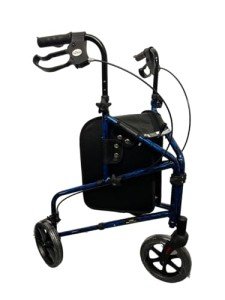This company has no active jobs
0 Review
Rate This Company ( No reviews yet )
About Us
10 Things That Everyone Is Misinformed About Seat Walker
The Seat Walker: A Comprehensive Guide to Mobility Aids
When it pertains to maintaining independence and mobility, people with limited mobility or disabilities typically count on different assistive devices. One such device that progressively comes to the forefront of mobility aids is the seat Handicap Walker. This article offers a thorough take a look at seat walkers– their features, benefits, types, and the factors to consider when picking one.
What is a Seat Walker?
A seat walker is a versatile mobility aid developed mainly for individuals who may have difficulty walking unaided. It usually features a frame with wheels, deals with for support, and a built-in bench or seat, enabling users to take breaks when required. Unlike standard walkers or rollators, which only provide support for walking, the inclusion of a seat makes the seat walker significantly more practical for lots of users.
Key Features of Seat Walkers
- Wheels: Most seat walkers are geared up with front wheels that improve mobility and ease of use, allowing users to move efficiently over different surfaces.
- Seat or Bench: The most distinguishing function is the integrated seat, which uses a resting place for users when tiredness sets in.
- Deals with: Adjustable manages cater to different user heights, providing sufficient assistance and guaranteeing a comfortable grip.
- Brakes: Safety brakes prevent the Modern Walker from rolling away when someone is seated, enhancing user security.
- Lightweight Frame: Many models are designed to be Ultra Lightweight 3 Wheel Rollator with Bag, making them simpler to transport and maneuver.
Benefits of Using a Seat Walker
Seat walkers have many benefits that make them a perfect option for many users.
- Boosted Mobility: They offer higher stability and assistance than conventional walkers, reducing the threat of falls.
- Convenience: The capability to rest at any point makes them ideal for those who tire easily or have restricted stamina.
- Independence: Seat walkers enable users to maintain a degree of self-reliance by allowing them to stroll and rest without assistance.
- Flexibility: Suitable for both indoor and outdoor use, these walkers can adjust to various environments.
- Exercise: Regular use encourages physical activity and social interaction, which can improve general wellness.
Kinds Of Seat Walkers
Various types of seat walkers cater to the varying needs of users. Here is a breakdown of the most typical types:
| Type | Functions | Best For |
|---|---|---|
| Fundamental Seat Walker | Easy design, typically with a Arebos Lightweight Rollator with Seat & Bag frame and very little functions. | Users requiring basic mobility assistance. |
| Durable Seat Walker | Reinforced frame, greater weight capability, often with larger seats. | People needing more robust assistance. |
| Rollator with Seat | Combines seats with multi-height adjustable handles and better maneuverability. | Users requiring regular resting alternatives. |
| Transfer Seat Walker | Developed for simple transport; typically folds and has a small footprint. | Active users who travel regularly. |
Picking the Right Seat Walker
Choosing a seat walker includes several factors to consider to ensure it satisfies the user’s specific requirements. Here are vital aspects to bear in mind:

- Weight Capacity: Ensure that the seat walker can support the user’s weight easily.
- Seat Height: Check the height of the seat to ensure it is proper and comfortable for the user.
- Width: Consider your living space and make sure the walker can fit through doors and narrow passages.
- Wheel Size: Larger wheels can handle rougher surface, while smaller sized wheels are better fit for indoor use.
- Weight of the Walker: A lightweight walker is useful for simple maneuverability and transport.
- Brakes and Safety Features: Look for trustworthy brakes and safety assurances, such as stability and anti-tip functions.
Setting a Budget
Seat walkers differ significantly in cost depending upon their features and construct quality. While it’s important to find a design that satisfies the user’s requirements, it’s similarly crucial to set an affordable budget plan.
Average Price Ranges:
- Basic Models: ₤ 50 to ₤ 150
- Rollators with Added Features: ₤ 150 to ₤ 300
- Durable Walker Models: ₤ 300 and up
FAQs About Seat Walkers
Q1: Who need to use a seat walker?A1: Seat walkers are perfect for people with restricted mobility due to age, injury, or persistent conditions who need extra support while walking. Q2: Are seat walkers safe?A2: Yes, seat walkers are created with safety in mind. They typically feature brakes, sturdy frames, and slip-resistant grips. Q3: How do I maintain my seat walker?A3: Regularly examine the brakes and wheels for wear and tear.
Clean the frame with a moist fabric and make sure
screws and components are tight. Q4: Can seat walkers be utilized outdoors?A4: Yes, lots of seat walkers are created for mymobilityscooters both indoor and outdoor use, though models with larger wheels carry out better on unequal surfaces. Q5: How do I know
which seat walker is ideal for me?A5: Consult with a healthcare supplier or occupational therapist who can examine your mobility needs and suggest suitable choices based upon your distinct scenario. The benefit and adaptability of seat walkers make them an important tool for those with mobility obstacles. By offering assistance, stability, and an opportunity for rest, they empower users to stay active and independent. When picking a seat walker, people should consider their individual requirements, lifestyle, and safety to find the best match for them. With the best seat walker, numerous users can enjoy a renewed sense of liberty, improving their lifestyle and preserving their self-reliance. In summary, whether one is navigating through the home, running errands, or enjoying fresh air in a park, a seat walker can prove to be a vital companion, transforming everyday activities into manageable tasks.


